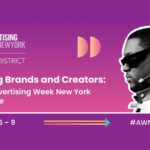By Alex Petrie, Group Account Director, Dog Digital
We’ve all been there. Chinese whispers, strong opinions…hardly the ideal environment to create amazing, impactful work. Working as part of an agency roster is tough at times, but it can equally be exciting. At Dog, we’ve had over 20 years of practicing how to navigate and get the best out of cross-agency partnerships and learned a lot along the way.
Most brand managers and marketing directors have a year’s budget and certain strategic objectives to meet within it. They might even have outlined their strategy or engaged with an agency to help them achieve it. So, how can brands make sure that the tactical levers at their disposal through the agency roster – whether it is PR, Social, SEO, CRM, ATL, Digital or Creative, are working in the best possible way to help them achieve their goals?
Interconnected planning breeds the best creative work
It’s no secret that it takes time and effort for a group of agencies to work together towards a collective purpose. But the rewards outweigh the investment. Start collaborating on the longer-term strategic planning sooner rather than later.
Taking this approach means that all parties can work with the client to determine which tactical levers need to be pulled, when and how often. Individual agencies can then truly harness their specific creative and activation expertise. This ensures that agencies can develop content and communications, together with tactical activation plans, that are designed to engineer very specific outcomes throughout the engagement journey and campaign lifecycles.
Develop the customer journey and understand the communications ecosystem
Agencies will gain a connected and holistic view of the project by defining the entire customer journey, understanding the context surrounding each touchpoint and interaction, and determining how to add the greatest value at each stage. Doing this means they’re less likely to fall into the trap of attempting to shoehorn content or communications designed for one channel into another. It will also ensure that budget isn’t wasted on campaign activations that haven’t been considered or planned for.
All roads lead back to the user
Keeping audiences that the client wants to engage at the heart of the work and putting them first from the beginning, rather than the channel or specialism each agency has been brought in to deliver, will lead to more focused and cohesive work. It’s a mindset shift that may be difficult to embrace, but getting it right sets a collective vision and purpose for all agency partners and client stakeholders.
Data supercharges all activity and empowers all agencies
Making sure data sets are connected and working effectively to provide the insights all agencies need throughout campaign lifecycles, empowers every agency on the roster to deliver more effective campaigns.
Having the right data to hand and shared among the relevant stakeholders in a timely fashion (rather than just looking at results at the end of each campaign), means agencies can take a longer-term view and optimise, automate and tailor multi-channel campaigns for different audiences. It’s this granular detail around sentiment, behaviours, interactions and user navigation across channels that will make campaigns more efficient, effective and better for both brand and consumer.
Creating a positive cross-agency working environment
Leadership is critical, both at the agency and client-side to get the best out of the delicate ecosystem of expertise and investment. Having a nominated project owner, with cross-channel knowledge, responsible for overseeing and communicating regularly on progress, priorities, blockers and risks, helps to keep a steady ship.
For a cross-agency environment to be successful, clarity is key, not just on roles and responsibilities, but on budgets, purpose and vision. Where there is a lack of clarity, uncertainty seeps in and people may feel overlooked or side-lined. Holding a cross-agency briefing at the very start of the campaign planning process helps to establish those roles and responsibilities. It means agencies can respond to the brief with a clear purpose and strategic direction.
After all, empowerment breeds great work. Setting up forums for communication, whether that’s a Teams or Slack channel, builds relationships among agency and client stakeholders. And having a separate one just for agencies is also beneficial, particularly during periods of activation. It means agencies can iron out minor issues, raise queries or share insights in real-time. Sorry clients, but it’s for your own benefit sometimes!
Conclusion
It’s important to remember that healthy and effective cross-agency rosters take time and effort on all parts. Teams take time to gel, especially when there are multiple personality types in the room. Acknowledging that it takes time for complex multichannel marketing to be effective and giving agencies space and opportunity to get to know the brand and each other, will ultimately lead to the best work.








